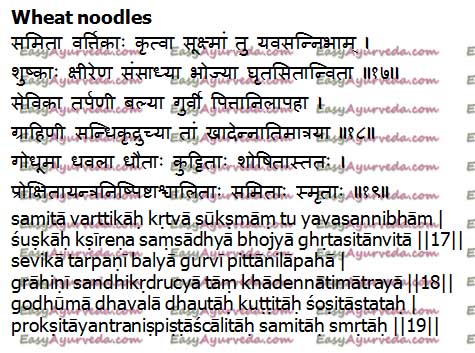Ayurvedic Wheat Noodles: How To Make? Benefits
This article is by Dr M S Krishnamurthy MD (Ayu)PhD.
The base materials used in the modern day noodles contain many flavoring agents, colouring materials, preservatives etc.
Most of the time they are loaded with artificial colors, tastemakers, preservatives, flavoring agents, adjuvants, binders, stabilizers etc.
In true sense how they are safe and to what extent they are acceptable or wholesome to the mass is still a question of debate. Where as in Ayurveda a unique kind of wheat noodle is explained and it is as follows-
Table of Contents
Classical reference

Classical reference: Bhavaprakasha – Kritaanna varga/19, 20
Wheat noodles
What is Sevika or Wheat noodles?
Texts explain classical wheat noodles in the name-Sevika in Sanskrit. In Sanskrit deerghasootri, dairghya sootrika – long threads, sootraannam (food in thread form) are used to denote noodles.
Even though noodles are prepared now a days out of rice powder or paste or dough of rice, classical Shevika refers to consider wheat flour for the above purpose.
Wheat flour is mixed with water and the dough is made ( It is heated or boiled now a days; earlier they used to keep it for sudation by making into bolus). It is pressed with the device specified for it (traditional noodle makers) and the thread noodles are obtained.
In one of the method these noodles are kept in sunshine and dried. Otherwise it is subjected for sudation/steam heating (by steamers).
(Note: Now a days salt or salt or cumin seeds are also added while making the dough. )
These dried noodles are taken and cooked well with milk, by adding ghee and sugar. Then it is served.
While serving, coconut milk, milk, Lassi etc are used as adjuvants nowadays.
Qualities, actions, applications
Qualities of wheat noodles –
Guru (heavy for digestion),
Pitta vatashamaka (balances pitta and vata dosha),
Kaphavardhaka (aggravates kapha dosha), brimhani (bulk enhancer).
Action:
Tarpani (nourishing),
Balya (tonic/energizer),
Grahi (absorbant),
Sandhana (helps in union of joints),
Ruchya (appetizer) etc.
Application:
As it is a heavy, excessive intake is not recommended. More over the classical preparation is not cooked appropriately; hence it is heavy for digestion. In addition, milk and sugar are also added. This increases the heaviness of the food. This food recipe is well advised to those who have good digestive capacity and suffering from Vata and Pitta disorders.
Bhavaprakasha text further that makes how the wheat flour should be prepared which is needed in the preparation of classical noodles, as follows-
The word used for wheat flour is ‘Samita’ in this context. The white colored wheat is taken and washed thoroughly with water. Later it is pounded well in a mortar and kept in sunshine by spreading in a tray. Further it is sieved and the obtained fine powder is preserved in closed containers.
Every point is made clear I n the literature…. because each process contributes in the quality of the final product. Now a days wheat is used without washing and it is a basic fact what we should learn from old literatures like Ayurveda!
Click to consult Dr MS Krishnamurthy MD (Ayu), PhD
Sevika as per Bhojana Kutuhalam
According to Bhojana Kutuhalam eighth chapter, Sevika is made with the maida flour, a dough is prepared and thin, small, round threads are made out of it. It is further cooked in milk, added with ghee and consumed.
Properties of the sevika:
Sevika is nourishing, strengthening, heavy to digest and alleviates pitta and vata. It is grahi, promotes reunion of broken parts and imparts taste. One should not eat it in excess.









2 comments
Abhimanyu Singh
The knowledge given by you is good and it gives to return the old age for better health.
Dr J V Hebbar MD(Ayu)Author
Thank you.